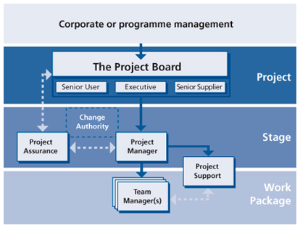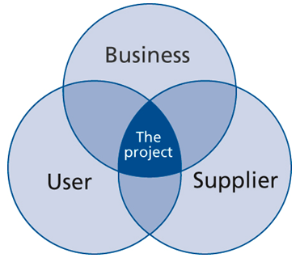PRINCE2 2009 - Directing Projects with PRINCE2 part 4
of the Cabinet Office under delegated authority from the Controller of HMSO.
Overview of PRINCE2
The role of senior management in PRINCE2
This manual is for Project Board members, who represent the most senior level of management in a PRINCE2® project.
Project Board members are accountable for the work they direct, but the extent of their business responsibilities is usually much wider than the project.
They can rarely afford to get involved in the detail of every project for which they are responsible.
This means that the effectiveness with which project work can be delegated is crucial.
The PRINCE2 Organization theme and the carefully integrated planning and control themes solve this problem by setting up an unambiguous framework of responsibilities.
In PRINCE2, the Project Board delegates the management of the project to the Project Manager in a series of stages - each based on an approved Stage Plan. Provided the Project Manager can deliver the stage within the tolerances defined in the plan, there is no necessity for the Project Board members to maintain close contact with the work.
The stage boundaries represent major control milestones - when the Project Board reviews whether the Project Manager has delivered the previous stage properly and approves a plan for the succeeding stage.
The PRINCE2 processes provide other checks and balances but, essentially, this is how senior managers on the Project Board are able to ‘manage by exception’.
Senior managers acting as Project Board members must also provide leadership and direction to ensure that their projects remain aligned to the organization’s strategic aims.
The Project Board is a guiding coalition that is necessary to support and direct the project.
As with company boards, if the composition of the Project Board is deficient then the project is likely to struggle.
If the Project Board is affected by in-fighting, the project is almost certainly doomed.
Appointing the right Project Board is probably the single most important factor in achieving a successful project.
The PRINCE2 project management team structure is illustrated in diagram 1.
Diagram 1
In order to be flexible and meet the needs of different environments and different project sizes, PRINCE2 does not define management jobs to be allocated to people on a one-to-one basis.
PRINCE2 defines roles, each of which is defined by an associated set of responsibilities.
These roles might be allocated, shared or combined according to the project’s needs.
The Project Board roles are more fully defined in the folder ‘Roles and responsibilities’ as part of the product package.
The three Project Board roles
ExecutiveAlthough the Project Board is responsible for the project, the Executive (supported by the Senior User(s) and Senior Supplier(s)) is ultimately accountable for the project’s success and is the key decision maker.
The Project Board is not a democracy controlled by votes.
The Executive’s role is to ensure that the project is focused throughout its life on achieving its objectives and delivering a product that will achieve the forecast benefits.
The Executive has to ensure that the project gives value for money, ensuring a cost-conscious approach to the project, balancing the demands of business, user and supplier.
The Executive is appointed by corporate or programme management during the pre-project process Starting up a Project.
The role of the Executive is vested in one individual, so that there is a single point of accountability for the project.
The Executive will then be responsible for designing and appointing the rest of the project management team, including the other members of the Project Board.
If the project is part of a programme, corporate or programme management may appoint some or all Project Board members.
Throughout the project, the Executive is responsible for the Business Case.
The Executive needs to be able to exercise a balanced view on behalf of the wider organization.
The Senior User(s) must be able to make decisions on behalf of those groups who will use or gain benefit from the project’s products.
The Senior Supplier(s) must be able to make decisions on behalf of the organization providing the expertise or resources to produce the products.
The Senior User(s) is responsible for specifying the needs of those who will use the project’s products, for user liaison with the project management team and for monitoring that the solution will meet those needs within the constraints of the Business Case in terms of quality, functionality and ease of use.
The role represents the interests of all those who will use the project’s products, those for whom the products will achieve an objective or those who will use the products to deliver benefits.
The Senior User role commits user resources and monitors products against requirements.
This role may require more than one person to cover all the user interests.
For the sake of effectiveness, the role should not be split between too many people.
The Senior User also represents the interests of those who will maintain the specialist products of the project after closure.
Exceptions to this do occur, such as when an external supplier maintains the products in service/operation as part of a maintenance/support agreement.
In fact, the distinction is not really important. What matters is that operations, service and support interests are represented appropriately from the outset.
As the beneficiary of the benefits, the Senior User(s) is held to account and must demonstrate to corporate or programme management that the forecast benefits that were the basis of project approval are, in fact, realized.
This is likely to involve a commitment beyond the end of the life of the project.
The Senior Supplier represents the interests of those designing, developing, facilitating, procuring and implementing the project’s products.
This role is accountable for the quality of products delivered by the supplier(s) and is responsible for the technical integrity of the project.
This role will include providing supplier resources to the project and ensuring that proposals for designing and developing the products are feasible and realistic.
If necessary, more than one person may be required to represent the suppliers.
The three primary categories of stakeholderIt is a PRINCE2 principle that the three primary categories of stakeholder must be involved in decision making if the project is to be successful, as shown in diagram 2.
Diagram 2
Business
The products of the project should meet a business need that will justify the investment in the project.
The project should also provide value for money.
The business viewpoint, therefore, should be represented to ensure that these two prerequisites exist before a project commences and remain in existence throughout the project.
The Executive role is defined to look after the business interests.
User
PRINCE2 makes a distinction between the business interests and the requirements of those who will use the project’s outputs.
The user viewpoint should represent those individuals or groups for whom some or all of the following will apply:
- They will use the outputs of the project to realize the benefits after the project is complete
- They will operate, maintain or support the project’s outputs
- The outputs of the project will impact them.
The user presence is needed to specify the desired outputs and ensure that the project delivers them.
The Senior User(s) will represent this stakeholder interest on the Project Board.
The creation of the project’s outputs will need resources with certain skills.
The supplier viewpoint should represent those who will provide the necessary skills and produce the project’s products.
The project may need to use both in-house and external supplier teams to construct the project’s products.
The Senior Supplier(s) will represent this stakeholder interest on the Project Board.
Logically, if the result of the project fails to meet the requirements of any of these three interests, the project has been unsuccessful.
PRINCE2 dictates that in order to ensure that the three interests are satisfied, they must be represented effectively in the project management team.
The three interests are safeguarded by ensuring that they are represented on the Project Board and in the Project Assurance roles.
It is the Project Board’s responsibility to assure itself that the project is being conducted correctly.
The Project Board members each have a specific area of focus for Project Assurance: namely business assurance for the Executive, user assurance for the Senior User(s) and supplier assurance for the Senior Supplier(s).
Project Board members may delegate assurance responsibilities to other qualified personnel (if they do not have time to undertake the assurance activities or do not have the specialist knowledge required).
Assurance personnel must be independent of the Project Manager but the intention is that the roles should be supportive.
The Project Manager is responsible for the day-to-day running of the project; the assurance roles are there to provide advice and support, not direction.
The level of overlap between the interests of the business, user and supplier will change according to the type of corporate organization and project: for example, if a project uses an in-house supplier, the business and user interests will be more likely to overlap than if an external supplier is used.
Note:
The term customer is also used in PRINCE2, normally in the context of a commercial customer/supplier relationship.
‘Customer’ can usually be interpreted as a collective term for the business and user interests.
However, one example of an exception to this broad rule would be where an organization is developing a new product to bring to market.
In this case the business interest is aligned with that of the supplier and ‘customer’ equates simply with ‘user’.
Where the user interest is external to the organization sponsoring the development, as in this example, it still needs to be represented in some way - perhaps by the sales/marketing function.
As well as the primary categories of stakeholder interests (business, user and supplier), which should be represented on the Project Board, there will be a wider range of stakeholders who may affect, or be affected by, the project.
These stakeholders may be internal or external to the corporate organization and may either support, oppose or be indifferent to the project.
Effective engagement with these stakeholders is key to a project’s success.
The Senior Responsible Owner (SRO) role has been introduced widely in the UK Government sector for large projects and programmes and is now used increasingly by others. The standard definition for the role is below.
The Senior Responsible Owner is the single individual with overall responsibility for ensuring that a project or programme meets its objectives and delivers the projected benefits.
It should be stressed that the SRO is not a PRINCE2 role.
However:
In the programme context, the Executive would report to the SRO appointed at programme level.
It might also be appropriate for the SRO to act as the Executive for major projects within the programme
Where an SRO is appointed in the context of a single large project, the person undertaking the SRO role would also undertake the Executive role or appoint the person who will undertake the Executive role.
All references above are in Directing Successful Projects with PRINCE2 unless stated otherwise.
PRINCE2® is a Registered Trade Mark of the Office of Government Commerce in the United Kingdom and other countries.
References to the 'manual' refer to the official publication by OGC. Everything in the manual is included in the product package.
Managing Successful Projects with PRINCE2 - 2005 edition
Managing successful Projects with PRINCE2 – 2009 edition
Directing Projects with PRINCE2.
plus:
The Complete Project Management package.
And much more besides - at a fantastic price.




